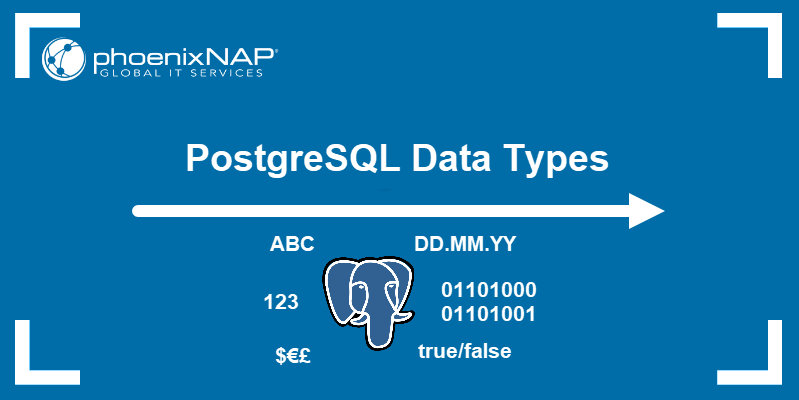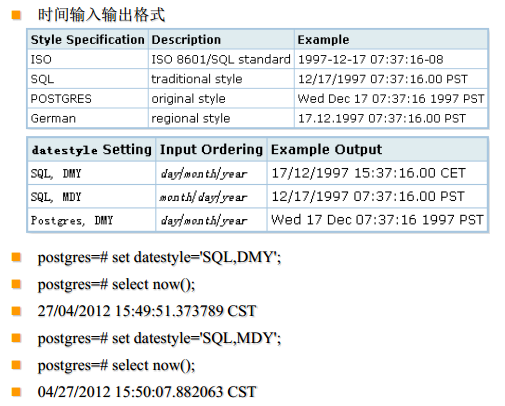

Postgresql data types update#
UPDATE people_cars SET cars = ARRAY WHERE person = 'Carol' Array Functions For this we need to supply the ARRAY keyword. Here we want to replace the second and third cars for Carol at the same time. UPDATE people_cars SET cars = array_replace(cars, 'Toyota Camy', 'Toyota Camry') WHERE person = 'Carol' Updating consecutive entries in the Array We can also use a PostgreSQL function for this, array_replace() as follows to change Toyota Camy to Toyota Camry. Here we replace Carol’s third car (typo intentional.) UPDATE people_cars SET cars = 'Toyota Camy' WHERE person = 'Carol' UPDATE people_cars SET cars = ARRAY WHERE person = 'Carol' Updating a single entry Examine the data after each execution by using SELECT. Now that we have data and can extract it, we will want to be able to update, add and remove data from the Array.Įxecute each of the following. SELECT UNNEST(cars) FROM people_cars WHERE person='Carol' Modifying Array Data Get all of Carol’s cars, each listed on it’s own row. To display a person’s list of cars as rows and not just a list, use the UNNEST operator. SELECT cars FROM people_cars WHERE person='Carol' īut Wait! What if I want the Array data in rows? UNNEST to the rescue Get the last two of Carol’s cars, Lexus LX470 and Tesla. Or equivalently, SELECT cars FROM people_cars WHERE person='Carol' SELECT cars FROM people_cars WHERE person='Carol' Get the first two of Carol’s cars, BMW and Lexus LX470. You can also leave off the starting or ending index. We can also specify a range of data items by using, starting index:ending index. Notice that the double quotes surrounding the array entry are removed. Suppose we want Carol’s second car, Lexus LX470. Suppose we want the first car of each person.Now let’s focus on selecting the specific data we want. We have already seen how we can use SELECT * (or just SELECT cars). Once we have data in the Array, of course we will want access to all or part of the data. Now let’s look at the data by executing the following code. INSERT INTO people_cars (person, cars) VALUES ('Carol', ARRAY ) Ģ. INSERT INTO people_cars (person, cars) VALUES ('Bob', '' ) Īnd use the second syntax for Carol’s cars.
Postgresql data types code#
Enter the code below and execute it to build add a list of cars for Bob.Notice in the second example,we use brackets instead of braces and single quotes instead of double quotes. We have two different syntax's for inserting data in to an Array using SQL. Now that we have a table ready to accept a list, we will want to insert data in to it. It is also worth noting you can specify a size for your array, text. We will keep our focus on one-dimensional arrays, and use SQL for our work. I used the text syntax originally because if you were to use pgAdmin’s table creation tool, this is what you would choose.Īn advantage of using SQL to build your table is you can specify a multi-dimensional array such as text.
Postgresql data types serial#
The tells PostgresSQL that you want an Array.Īn alternate syntax if you’d like to try it would be, DROP TABLE people_cars CREATE TABLE people_cars ( id Serial Primary Key NOT NULL, person Varchar(50) NOT NULL, cars text ARRAY ) CREATE TABLE people_cars ( id Serial Primary Key NOT NULL, person Varchar(50) NOT NULL, cars text ) Enter the code below and execute it to build our people_cars table.

Let’s Get Started! Building A Table with An Array Data Type

Important: You may be used to working with Arrays in JavaScript or some other programming language.


 0 kommentar(er)
0 kommentar(er)
